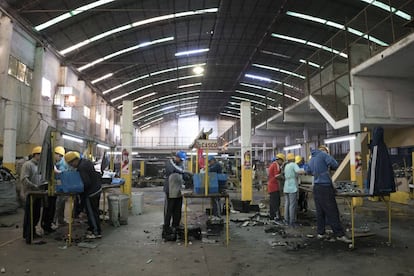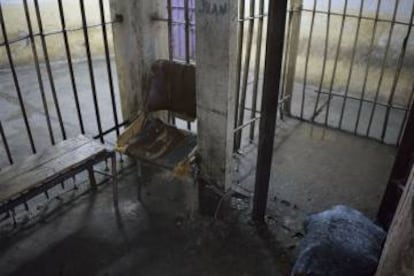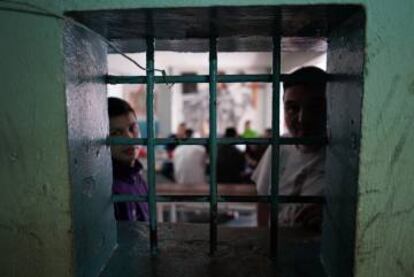Argentina’s prison system: outdated, under-resourced and overcrowded
EL PAÍS visits one of the country’s toughest jails, Olmos in Buenos Aires

Built to hold 26,000 prisoners, the jails of Buenos Aires, Argentina’s largest province, are currently holding a population of 33,000, and the number is rising fast. “We inherited a penitentiary system where there are deficiencies with the food, drinking water, health, education and employment,” admitted Justice Minister Gustavo Ferrari as he announced plans for a major overhaul in July.
Last week, EL PAÍS visited one of worst jails in Buenos Aires province, Olmos, built in the 1930s for 2,100 prisoners. At present, it has a population of 2,468. Located some 30 kilometers southeast of Buenos Aires at the mouth of the River Plate, the prison has seen sea air eat away at its walls, high-tension cables and fittings. Damp invades every inch of the institution. Some areas are flooded and cannot be used.
As well as violence between inmates, there have been reports of torture
Rising crime has led to calls for more police on the streets of Buenos Aires and for more criminals to be locked up. The problem is that there is no more room in the province’s jails: the population behind bars is growing at a rate of 1,600 inmates a year. What’s more, up to half of prisoners reoffend once they have served their time.
The regional administration of Buenos Aires has promised to build more jails, but lacking the funds, will not do so for another decade
“Nobody wants to spend money on jails. People are demanding more police on the streets, more arrests. But where does all this end? With more people in jail. And what do we do with them? Here we try to give them an education, a trade, we do what we can, but we don’t have the resources,” says Horacio Piedrabuena, the governor of Olmos prison as he guides us through run-down corridors and rusty staircases.

“It’s hard to convince people that we need to spend money on jails as well as finding ways to keep young people out, and to look for alternatives to prison, because once somebody has been behind bars they are more likely to reoffend than start a new life when their sentence is over. We are already seeing a third generation here of grandchildren of people who have stolen,” he says.
The prisoners in Olmos do their best to do something useful with their time and even earn some money that they use to help renovate the prison. Some 22 prisoners aged between 18 and 21 who live next to each other in three cells are making origami swans that their families hope to sell. “It’s a micro-enterprise to buy materials to renovate the wing. With this money we could lay some new tiles in the showers,” says Daniel, a prisoner here.

Other prisoners are making brooms out of plastic soft drinks bottles, cutting them in to narrow strips, while another group is dismantling old computers to sell the parts. More ambitious prisoners have even managed to complete university degrees.
“We need a plan. Our prisons have been forgotten for years, many of them date back to the end of the 19th century,” says Ferrari, who says he intends to reopen the jail’s hospital, which was closed six years ago, as well as rebuilding some areas to create new cells.
Overpopulation is the main problem in Argentina’s jails, but not the only one. As well as violence between inmates, there have been reports of torture, as a 2015 survey overseen by an independent commission confirms. It visited 28 prisons, carrying out a total of 45 inspections, and reported 12,787 complaints of torture and mistreatment.

Ferrari admits torture takes place. “We have 300 confirmed cases and we have also sacked a number of guards who had been found guilty of torture but who were still working,” he says, adding that since he took over in May, there have been real improvements.
Argentina’s middle classes continue to demand a tougher line with criminals, and there have even been a number of high-profile cases where people who have taken the law into their own hands have garnered widespread public sympathy. But while the debate continues over what to do about Argentina’s soaring crime rates, the prison population continues to rise in an already overcrowded system.
English version by Nick Lyne.
Tu suscripción se está usando en otro dispositivo
¿Quieres añadir otro usuario a tu suscripción?
Si continúas leyendo en este dispositivo, no se podrá leer en el otro.
FlechaTu suscripción se está usando en otro dispositivo y solo puedes acceder a EL PAÍS desde un dispositivo a la vez.
Si quieres compartir tu cuenta, cambia tu suscripción a la modalidad Premium, así podrás añadir otro usuario. Cada uno accederá con su propia cuenta de email, lo que os permitirá personalizar vuestra experiencia en EL PAÍS.
¿Tienes una suscripción de empresa? Accede aquí para contratar más cuentas.
En el caso de no saber quién está usando tu cuenta, te recomendamos cambiar tu contraseña aquí.
Si decides continuar compartiendo tu cuenta, este mensaje se mostrará en tu dispositivo y en el de la otra persona que está usando tu cuenta de forma indefinida, afectando a tu experiencia de lectura. Puedes consultar aquí los términos y condiciones de la suscripción digital.
More information
Últimas noticias
Half of Scotland is in the hands of 420 property owners
Pinochet’s victims grapple with José Antonio Kast’s rise in Chile
Reinhard Genzel, Nobel laureate in physics: ‘One-minute videos will never give you the truth’
From digital curfews to blocking apps: How technology experts protect their children online
Most viewed
- Pablo Escobar’s hippos: A serious environmental problem, 40 years on
- Reinhard Genzel, Nobel laureate in physics: ‘One-minute videos will never give you the truth’
- Why we lost the habit of sleeping in two segments and how that changed our sense of time
- Charles Dubouloz, mountaineering star, retires at 36 with a farewell tour inspired by Walter Bonatti
- The Florida Keys tourist paradise is besieged by immigration agents: ‘We’ve never seen anything like this’










































